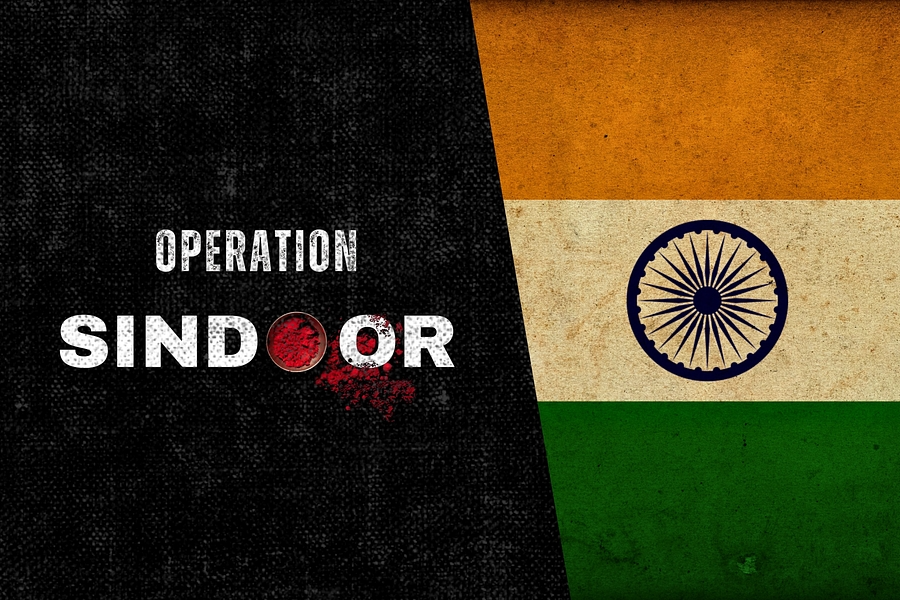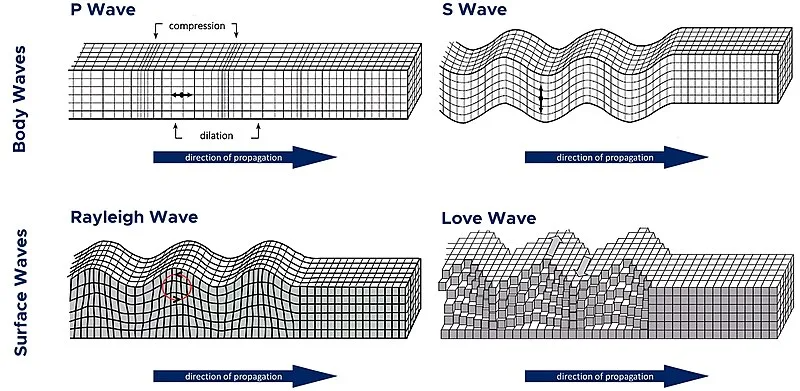September 24th Current Affairs
Table of Contents
Kannada Literature Optional Syllabus
Home / ಐಚ್ಚಿಕ ಕನ್ನಡ ಸಾಹಿತ್ಯದ ಪಠ್ಯಕ್ರಮ ಐಚ್ಚಿಕ ಕನ್ನಡ ಸಾಹಿತ್ಯ ಪತ್ರಿಕೆ – 1 ವಿಭಾಗ – ಎ ಅ) ಕನ್ನಡ ಭಾಷೆಯ ಚರಿತ್ರೆ ಭಾಷೆ
UPSC Current Affairs – October 6th
October 06th Current Affairs Home / Table of Contents 36-hour curfew imposed in parts of Odisha’s Cuttack over communal tensions
Religious Minorities in India and the Challenge of Communal Harmony: A Sociological Reflection on the Cuttack Violence
Home / Religious Minorities in India and the Challenge of Communal Harmony: A Sociological Reflection on the Cuttack Violence Sociology
UPSC Current Affairs – October 4th
October 04th Current Affairs Home / Table of Contents Isabgol Processors threaten to halt purchases from October 6th over GST
Sologamy and Contemporary Trends in Marriage: A Sociological Perspective
Home / Sologamy and Contemporary Trends in Marriage: A Sociological Perspective Sociology Paper 1: Systems of Kinship – Contemporary trends
UPSC Current Affairs – October 3rd
October 03rd Current Affairs Home / Table of Contents NASA IMAP to show how solar particles are energised and shield
Understanding Indian Festivals through Durkheim: Religion, Rituals, and Collective Conscience
Home / Understanding Indian Festivals through Durkheim: Religion, Rituals, and Collective Conscience Sociology Paper 1: Émile Durkheim – Religion and
UPSC Current Affairs – September 30th
September 30th Current Affairs Home / Table of Contents Ladakh groups reject talks with government, Ministry says open to dialogue
Caste Census in India: A Sociological Perspective
Home / Caste Census in India: A Sociological Perspective Sociology Paper 2: Caste System – Features of Caste system. The
Constitutional Morality: Upholding India’s Democratic Ethos
Home / Constitutional Morality: Upholding India’s Democratic Ethos Sociology Paper 2: Visions of Social Change in India – Constitution, law,
Trump at UNGA: US president targets India repeatedly in rambling speech, makes outrageous 'war' and 'peace' claims

Relevance to UPSC
GS Paper II: International Relations & Foreign Policy
Highlights dynamics in India–U.S. relations, especially issues of diplomacy, public statements, and bilateral narrative.
Shows how great power competition and alignment (e.g. U.S., India, China, Russia) plays out in multilateral fora like the UNGA.
Brings in the role of energy diplomacy, sanctions, and how countries navigate global conflicts (e.g. Russia-Ukraine) and their spillover into relations with India.
Underscores the use of public diplomacy / narrative warfare in international relations: how leaders’ speeches can influence global perception and bilateral postures.
More About the News
- In his UNGA speech, President Donald Trump claimed he had ended the conflict between India and Pakistan, and accused India and China of financing Russia’s war in Ukraine through continued oil purchases.
- Trump asserted he had “ended seven wars in seven months” including the India-Pakistan conflict, despite denials from New Delhi about any U.S. role.
- India’s Ministry of External Affairs rejected Trump’s accusations as “unjustified and unreasonable,” defending India’s energy imports as driven by global market imperatives and national interest.
India - USA Relations
India–US relations have transitioned from Cold War estrangement to a broad strategic partnership rooted in shared security interests, economic cooperation, and vibrant societal linkages. Over the past decade, defence agreements, structured dialogues, and trade initiatives have deepened ties, even as periodic frictions over tariffs and regulations highlight the relationship’s pragmatic and transactional dimensions.
Evolution
- Cold War to Post-Cold War (1947–1998): Limited engagement due to India’s non-alignment and US strategic focus elsewhere; some trade and cultural links existed.
- Post-Kargil and 1998–2004 shift: India’s nuclear tests and subsequent sanctions were followed by a gradual thaw and security dialogue in the late 1990s/early 2000s.
- Strategic partnership growth (2004–2014): Civil nuclear cooperation, growing trade and education linkages, and deeper diplomatic contacts.
- Major defence and strategic convergence (2014–2020): Elevation to a Comprehensive Global Strategic Partnership; signing of logistics and communications agreements (LEMOA/COMCASA/BECA) and designation as Major Defense Partner.
- Broadening into technology, clean energy, and supply chains (2020s): Collaboration on semiconductors, critical minerals, space, counter-terrorism and Quad multilateralism; simultaneous growth of economic interdependence and episodic trade tensions.
Strengths in the Relations
Strategic & Defence Cooperation: Sustained military interoperability and intelligence sharing.
Example: Foundational pacts (LEMOA/COMCASA/BECA) and regular 2+2 and joint exercises (Yudha/Cope India).Economic Complementarity & Investment Flows: Large bilateral trade and significant US FDI into India’s tech, pharma and services sectors.
Example: US companies’ investments in India’s manufacturing and MRO projects (2024–25 MRO initiative).Technology & Research Collaboration: Cooperation in space, semiconductors and critical tech.
Example: Semiconductor partnerships and R&D collaboration announced in 2024–25.Diaspora & People-to-People Ties: Large Indian diaspora in the US that supports remittances, entrepreneurship and soft power.
Example: IT professionals and academics contributing to US–India ties.Multilateral & Regional Convergence: Shared interests in Indo-Pacific security, counter-terrorism and climate action.
Example: Cooperation inside the Quad to balance regional coercion.
Weaknesses in the Relations
Trade Frictions & Protectionism: Sudden tariff actions or trade restrictions can strain ties.
Example: 2025 US tariffs and additional duties affecting Indian exporters.Migration & Labour Policy Disagreements: Visa rules and fees create political and corporate friction.
Example: H-1B reforms and fee hikes in 2025.Asymmetric Expectations on China: Divergence when India pursues strategic autonomy or hedging.
Example: Contrasting votes of India & USA on Palestine’s representation in the 80th Session of UNGA.Data, Privacy & Regulatory Differences: Differing standards on cross-border data flows, tech regulation and digital taxation create business uncertainty.
Geopolitical Conditionalities vs Strategic Autonomy: India resists being drawn into binaries.
Common Groupings / Multilateral Platforms
- Quad (Quadrilateral Security Dialogue): India, US, Japan, Australia — Indo-Pacific cooperation.
- Bilateral 2+2 & Strategic Dialogues: Regular ministerial/leader-level meetings and specialised dialogues (defence, commerce, tech, energy).
- Multilateral fora: G20, UN, IAEA, WTO — platforms for converging interests on global governance.
- Commercial & business groupings: CEO forums, strategic economic dialogues for supply chains and investment.
Major Initiatives Taken
- Foundational defence agreements: LEMOA, COMCASA, BECA (operationalising defence interoperability).
- Comprehensive Global Strategic Partnership & 2+2 dialogues: Institutionalised high-level coordination across security and diplomacy.
- Semiconductor and critical-tech partnerships: Joint semiconductor cooperation and US support for Indian manufacturing (announced 2024–25).
- Civil nuclear cooperation & energy ties: Longstanding nuclear dialogue and growing clean energy collaboration.
- Economic engagement goals: Roadmaps to expand trade and investment, supply-chain diversification initiatives.
Recent Strains (explicit examples: tariffs, H-1B, fees, etc.)
- High tariffs on Indian exports (2025): US imposed steep additional duties affecting textiles, gems, footwear and other sectors, triggering exporter concerns and market shocks.
- H-1B visa fee hikes and restrictions (2025): Dramatic increase in H-1B fee proposals (reported $100,000 one-time fee) is causing disruption to Indian IT firms and diaspora mobility.
- Political rhetoric & transactional policy swings: Periodic politicisation of trade/immigration in US domestic politics affecting bilateral warmth.
- Supply-chain and tech export controls: US scrutiny of tech transfers and ITAR/ITAR-like reviews — complicating defence and dual-use commerce.
Challenges in the Relationship
Economic Vulnerability to Policy Shocks: Sudden policy changes can disrupt trade, IT earnings, and currency stability.
Example: Sudden tariffs and H-1B fee hikes affecting exports and IT sector revenues.Balancing China while Deepening US Ties: India must deter Chinese coercion while safeguarding strategic autonomy.
Example: Independent positions taken by India at multilateral fora.Technology Transfer & Sovereignty Concerns: Challenge of securing advanced tech transfers without undermining national security or industrial policy.
Example: Semiconductor and defence technology negotiations.Diaspora & Mobility Pressures: Visa policy shifts impact skilled migration, remittances, and workforce planning.
Example: H-1B dependency affecting Indian professionals abroad.Domestic Political Cycles & Policy Volatility: US domestic politics can trigger abrupt trade and immigration measures, requiring diplomatic management by India.
Example: Policy reversals linked to changing US administrations.
How Challenges are Countered
Diversifying Economic Partnerships & Markets: India expands trade with EU, ASEAN, Middle East and African partners to reduce single-market exposure.
Example: Enhanced engagement with EU and regionally focused FTAs.Strengthening Domestic Capacity (Atmanirbhar & Supply-chain build-out): Scaling semiconductor fabs, manufacturing incentives, and MRO facilities to reduce external dependencies.
Diplomatic Engagement & High-Level Talks: Rapid leader-level and ministerial dialogues to defuse trade/visa tensions and negotiate workarounds.
Example: 2+2 dialogues and commerce talks.Leveraging Multilateralism & Coalitions: Using Quad and plurilateral groupings to coordinate security and economic responses without singular dependence.
Domestic Policy Adjustments & Legal Remedies: Legal recourse, negotiations, export controls reciprocity, and incentives to retain domestic jobs while protecting strategic industries.
Way Forward
- Institutionalise trade dispute mechanisms that can quickly address sudden tariff/fee actions and provide predictable redress.
- Accelerate strategic economic decoupling where necessary (build local capabilities in semiconductors, critical minerals, defence manufacturing).
- Deepen technology partnerships with safeguards (tiered access, shared IP frameworks) that balance transfer with national security.
- Enhance people-to-people linkages while negotiating fair mobility frameworks (reform H-1B negotiations into sustainable, bilateral talent mobility).
- Expand climate and global governance cooperation to provide positive common ground and reduce transactionalism.
The India–US partnership has evolved into a strategic framework anchored in defence, technology, and economic cooperation, though it remains sensitive to policy shifts and transactional strains. Strengthening institutional mechanisms, ensuring stable trade and mobility frameworks, and advancing India’s strategic capacities are essential to mitigate friction. With long-term vision and predictability, the relationship can transition from episodic collaboration to enduring strategic interdependence.
Prelims MCQ
Q. Which of the following accurately describe the institutional measures that have deepened India–US defence cooperation in the 2010s–2020s? 1. Logistics Exchange Memorandum of Agreement (LEMOA) enables reciprocal logistics support between the two militaries. 2. Communications Compatibility and Security Agreement (COMCASA) facilitates secure communications and data links for defence platforms. 3. BECA (Basic Exchange and Cooperation Agreement) chiefly covers geospatial and topographic data sharing. 4. India’s designation as a Major Defense Partner (MDP) automatically gives India veto power over US arms sales to other countries in South Asia. Select the correct answer:
A. 1, 2 and 3 only
B. 1 and 4 only
C. 2 and 4 only
D. All of the above
Mains Question
Q. India–US relations are marked by strong strategic and economic convergence but remain vulnerable to policy shifts and transactional politics. Discuss the key areas of cooperation and friction, and suggest measures to ensure a more stable and enduring partnership.
Online betting app case: Cricketer Yuvraj Singh appears before ED

Relevance to UPSC
GS Paper III: Economy, Prevention of Money Laundering Act, etc.
Touches upon the shadow economy / illicit finance flows and how illegal online betting platforms may facilitate money laundering.
Raises the challenge of regulating digital financial transactions, cross-border flows, and tax evasion in an era of online platforms.
Relates to cyber regulation, digital platform governance, and how the government monitors, restricts or bans harmful digital services (like real-money gaming).
Implicates financial sector integrity and risk, since infiltration by illicit funds can disrupt legitimacy and trust in financial systems.
More About the News
- Former Indian cricketer Yuvraj Singh appeared before the Enforcement Directorate (ED) in connection with a money laundering probe tied to the online betting app 1xBet.
- His statement was recorded under the Prevention of Money Laundering Act (PMLA), and the ED is probing how celebrities were linked to these gambling platforms, how payments were made, and whether tax evasion or illegal financial transactions were involved.
- The investigation has already involved other cricketers (Suresh Raina, Shikhar Dhawan, Robin Uthappa) and public figures, and looks into issues of unauthorized online gaming, promotional activities, and illicit fund flows.
Online Betting Apps
Online betting apps have gained significant traction in India, fueled by widespread smartphone usage and internet penetration. However, their rapid growth has raised concerns regarding regulation, user protection, and societal impacts.
Evolution of Online Betting Apps in India
- Early 2010s: Emergence of fantasy sports platforms like Dream11.
- Mid-2010s: Introduction of sports betting apps offering real-money wagers.
- Late 2010s: Surge in mobile-based betting platforms with user-friendly interfaces.
- 2020s: Expansion into various sports and casino games, attracting a diverse user base.
- 2025: Government intervention through the Promotion and Regulation of Online Gaming Bill, 2025, imposing a ban on real-money online games.
Key Data Sets
- Market Size: The Indian online gambling market generated USD 5,015.9 million in 2024 and is expected to reach USD 10,776.7 million by 2030.
- Sports Betting Segment: Dominated the market with a revenue share of 57.41% in 2024.
- Growth Rate: Projected CAGR of 13.7% from 2025 to 2030.
- User Base: Platforms like Dream11 reported 10 million daily active users in 2025.
- Mobile Penetration: Mobile platforms hold a dominant market share due to the rising number of smartphone users.
Potential of the Market in India
- Large User Base: Over 840 million internet users, with a significant portion engaging in online gaming.
- Youth Demographic: A young population inclined towards digital entertainment.
- Technological Advancements: Improved mobile networks and payment systems facilitating seamless gaming experiences.
- Revenue Generation: Potential for substantial tax revenues if regulated appropriately.
- Global Appeal: Attracting international gaming companies seeking to tap into the Indian market.
Advantages of Online Betting Apps
- Accessibility: Users can place bets anytime and anywhere via mobile devices.
- Variety of Games: Offers a wide range of sports and casino games to choose from.
- Convenient Transactions: Integration with digital payment systems for easy deposits and withdrawals.
- User Engagement: Features like live streaming and in-app promotions enhance user experience.
- Economic Opportunities: Creation of jobs in tech, marketing, and customer support sectors.
Disadvantages of Online Betting Apps
- Addiction Risks: Potential for users to develop gambling addictions.
- Financial Losses: Users may incur significant monetary losses.
- Legal Ambiguities: Unclear regulations leading to potential legal issues.
- Fraudulent Activities: Instances of scams and fraudulent platforms deceiving users.
- Data Privacy Concerns: Risk of personal and financial data being compromised.
Impacts of Online Betting Apps
- Economic Impact: Potential increase in government revenues through taxation.
- Social Impact: Can lead to social issues like addiction and financial distress.
- Technological Advancements: Promotes development in digital payment systems and mobile applications.
- Employment Opportunities: Job creation in various sectors associated with online gaming.
- Regulatory Challenges: Necessitates the development of robust legal frameworks.
Challenges Faced
- Regulatory Uncertainty: Lack of clear and consistent regulations across states.
- User Protection: Ensuring the safety and security of users’ personal and financial information.
- Market Saturation: High competition among numerous platforms.
- Technological Issues: Ensuring the reliability and fairness of gaming algorithms.
- Public Perception: Overcoming societal stigma associated with gambling.
Recent Regulations and Government Measures
- Promotion and Regulation of Online Gaming Bill, 2025: Bans real-money online games and related advertisements.
- Online Gaming Authority: Established to oversee and regulate online gaming activities.
- State-Level Regulations: States like Tamil Nadu have implemented their own laws to regulate online gambling.
- Banning of Apps: Several betting apps have been banned for violating regulations.
- Enforcement Actions: Agencies like the Enforcement Directorate have taken actions against illegal platforms.
Way Forward
- Clear Regulations: Establishing uniform regulations across the country.
- Public Awareness: Campaigns to educate the public about the risks and legalities of online betting.
- Technological Innovations: Development of secure and transparent gaming technologies.
- International Collaboration: Engaging with global bodies to set standards and share best practices.
- Monitoring and Enforcement: Strengthening mechanisms to monitor and enforce regulations.
Comparison: Online Betting Apps vs. Traditional Betting Games
Feature | Online Betting Apps | Traditional Betting Games |
Accessibility | Available 24/7 via mobile devices | Limited to physical locations and operating hours |
Variety | Wide range of games and sports | Limited to specific games and events |
Convenience | Easy deposits and withdrawals via digital platforms | Cash-based transactions with physical presence |
Regulation | Subject to digital platform regulations | Governed by local gambling laws |
User Experience | Interactive features like live streaming and in-app promotions | Static environment with limited interaction |
The online betting app industry in India has experienced rapid growth, driven by technological advancements and a large user base. While offering numerous advantages, it also presents significant challenges that require comprehensive regulatory frameworks. Moving forward, a balanced approach focusing on user protection, responsible gaming, and innovation will be essential for the sustainable development of this sector.
Prelims MCQ
Q. Consider the following statements regarding online betting apps in India: 1. Online betting apps offer 24/7 access and facilitate real-time transactions through digital platforms. 2. They are uniformly regulated across all states in India under a central legal framework. 3. Online betting apps have a higher potential for addiction and financial loss compared to traditional betting games. 4. The Promotion and Regulation of Online Gaming Bill, 2025, imposes a ban on all forms of fantasy sports and online betting. Which of the above statements are correct?
A. 1 and 3 only
B. 1, 3 and 4 only
C. 2 and 4 only
D. All of the above
Mains Question
Q. Online betting apps in India have seen rapid growth due to technological advancements and a large digital user base, but they also pose significant regulatory, social, and economic challenges. Discuss.
Ayushman Bharat effected revolution in public healthcare: PM Modi
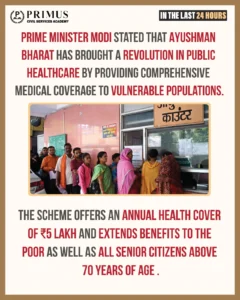
Relevance to UPSC
GS Paper II: Social Justice, Governance & Health Policy
Health policy & schemes: Ayushman Bharat is one of the flagship health schemes; its successes, challenges, and implementation are directly relevant to evaluation of health policies.
Role of government & welfare state: It speaks to how the state intervenes to protect citizens against catastrophic health spending, a core welfare function.
Governance & delivery challenges: Issues of implementation, beneficiary identification, fraud, empanelment of hospitals, and regulatory oversight are implicit with such schemes.
Public health & social security linkages: The scheme bridges health and social protection domains, making it relevant in debates on universal healthcare / access.
More About the News
- Prime Minister Modi stated that Ayushman Bharat, now 7 years since its launch, has brought a “revolution in public healthcare” by offering financial protection and dignity to beneficiaries.
- The scheme offers an annual health cover of ₹5 lakh, and its coverage now includes poor families and all senior citizens above 70 years.
- PM claimed that since its implementation, India’s out-of-pocket healthcare expenditure has dropped (from ~63% to ~39%) and many families are spared from financial ruin due to illnesses.
Ayushman Bharat
Ayushman Bharat is India’s flagship initiative to achieve universal health coverage by integrating health insurance and primary healthcare delivery. It addresses both financial protection through PM-JAY and accessible primary care through Health and Wellness Centres (HWCs). The scheme represents a significant step toward equitable healthcare, especially for vulnerable populations.
Evolution
- Pre-2017: Need for universal health coverage emphasized in National Health Policy 2017.
- 2018: Launch of Ayushman Bharat by PM Narendra Modi.
- PM-JAY: Provides ₹5 lakh per family per year for secondary and tertiary hospitalization.
- Health and Wellness Centres (HWCs): Transform 1.5 lakh Sub-Centres and PHCs into comprehensive primary care units.
- 2020–25: Expansion into more states, integration with digital health records, telemedicine, and preventive care services.
Key Data Sets
- Beneficiaries: 10+ crore families as per SECC database.
- Empanelled Hospitals: 30,000+ hospitals nationwide.
- Hospital Admissions Covered: 2+ crore claims processed since inception.
- Coverage Amount: Up to ₹5 lakh per family per year.
- HWCs: Target of 1.5 lakh centres by 2025.
Features & Beneficiaries
- Comprehensive Coverage: Hospitalization expenses for secondary and tertiary care.
- Cashless & Paperless: Digital claim processing at empanelled hospitals.
- Portability: Beneficiaries can access services across India.
- Focus on Vulnerable Groups: Targeting poor and vulnerable families identified via SECC.
- Preventive & Primary Care: Through HWCs providing maternal, child, NCD, and wellness services.
Eligibility Criteria
- Families listed under Socio-Economic Caste Census (SECC) 2011 data.
- No cap on family size or age.
- Automatic inclusion for identified economically vulnerable families.
Scheme Type
- Central Sector Scheme with funding and implementation shared with states (PM-JAY is centrally funded, HWCs are state-implemented).
Benefits
Financial Protection: Reduces out-of-pocket expenditure.
Example: A poor family can claim a ₹5 lakh hospitalization cover without personal expense.Access to Quality Care: Empanelled hospitals ensure better treatments.
Example: Rural patients receiving tertiary care in urban hospitals.Digital & Cashless System: Simplifies claim process.
Example: Aadhaar-linked claims enable instant cashless settlement.Comprehensive Healthcare: Covers preventive, promotive, and curative care via Health & Wellness Centres (HWCs).
Example: NCD screening at local centres.Economic Benefits: Reduces impoverishment due to medical costs.
Example: Families avoid debt for critical surgeries.
Impacts
- Health Outcomes Improvement: Increased institutional deliveries and surgeries.
- Financial Security: Reduced catastrophic health expenditure in rural households.
- Employment Generation: Creates jobs in hospitals and administrative management.
- Healthcare Access: Strengthens rural-urban access parity through portable benefits.
- Data-Driven Policy: Claims data informs health policy and resource allocation.
Challenges Faced
Awareness Gaps: Many eligible families are unaware of the scheme.
Example: Remote tribal areas have low enrolment.Fraud & Misuse: Ghost claims and malpractices in some empanelled hospitals.
Infrastructure Limitations: Shortage of doctors and essential equipment in rural Health & Wellness Centres (HWCs).
Inter-State Portability Issues: Delays in claim settlement when patients move across states.
Sustainability Concerns: Rising fiscal burden due to increasing claims and hospital costs.
Best Practices
India:
- Kerala’s state health insurance integration for smooth claim settlements.
- Tamil Nadu’s mobile health units are linked with PM-JAY for outreach.
Global:
- Thailand’s Universal Coverage Scheme will ensure free health services to all citizens.
- Brazil’s SUS (Sistema Único de Saúde) will integrate primary and tertiary care with financial protection.
Way Forward
- Strengthen awareness campaigns in rural and remote areas.
- Improve digital infrastructure for cashless and fraud-free claim processing.
- Expand HWCs and integrate telemedicine and diagnostics.
- Foster inter-state portability and seamless claim settlement.
- Monitor fiscal sustainability and periodically revise coverage and rates.
Ayushman Bharat has transformed India’s healthcare landscape by combining financial protection with primary care access. Continued digital integration, capacity building, and robust monitoring can make it a sustainable model. If implemented effectively, it can serve as a blueprint for universal health coverage in developing economies.
Prelims MCQ
Q. Which of the following statements about Ayushman Bharat are correct?
1. PM-JAY provides up to ₹5 lakh per family per year for secondary and tertiary hospitalization.
2. HWCs provide only preventive care and exclude curative services.
3. The scheme is a central sector scheme with state participation.
A. 1 only
B. 1 and 2 only
C. 1 and 3 only
D. All of the above.
PM-JAY covers ₹5 lakh per family (statement 1) and the scheme is centrally funded with state participation (statement 3). HWCs provide both preventive and curative services, so statement 2 is incorrect.
Mains Question
Q. Ayushman Bharat integrates health insurance and primary care to improve healthcare access and financial protection for vulnerable populations. Analyse its evolution, key impacts, and implementation challenges, and suggest measures to strengthen the scheme for universal health coverage.
'Nation that bombs own people': India tears into Pakistan at UNHRC; calls for objectivity
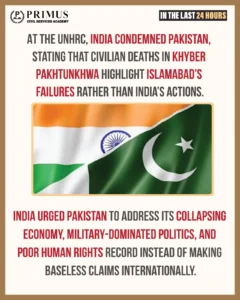
Relevance to UPSC
GS Paper II: International Relations, Foreign Policy, Diplomacy & Institutions
India–Pakistan relations: The exchange at UNHRC reflects continuing diplomatic contention, narrative control, and rivalry.
Multilateral institutions & norms: India’s call for objectivity and non-selectivity in the UNHRC speaks to the role of international institutions and how states attempt to influence them.
Human rights diplomacy: The case shows how human rights forums are used by states for political leverage, and how human rights accusations become part of diplomatic narrative.
Soft power and moral persuasion: India’s strategy here involves asserting moral high ground and attempting to shape global opinion.
More about the News
- At the 60th session of the United Nations Human Rights Council (UNHRC), India sharply criticized Pakistan’s statements and conduct, accusing it of misusing the forum with “baseless and provocative statements.”
- India accused Pakistan of air strikes in Khyber Pakhtunkhwa that allegedly killed civilians, stating Pakistan should focus on its internal human rights record rather than attacking others.
- In its reply, India called for objectivity, non-selectivity and universality in the UNHRC, and urged member states not to allow the Council to be used for political vendettas.
United Nations Human Rights Council (UNHRC)
The United Nations Human Rights Council (UNHRC) is an intergovernmental body within the UN system responsible for promoting and protecting human rights globally. It provides a platform for dialogue, monitoring, and addressing violations, while also assisting member states in improving human rights practices.
Evolution
- 1946: Establishment of the UN Commission on Human Rights (UNCHR) to promote human rights and draft international norms.
- 2006: UNHRC was created by UN General Assembly Resolution 60/251, replacing the UNCHR due to concerns over its credibility and effectiveness.
- Present: UNHRC holds regular sessions and special sessions to address urgent human rights issues, working closely with the Office of the High Commissioner for Human Rights (OHCHR).
Members
- Composition: 47 member states elected by the UN General Assembly.
- Term: Each member serves a three-year term, with a maximum of two consecutive terms.
- Regional Distribution: Seats are allocated based on equitable geographical distribution among regional groups.
Administration and Procedures
- Sessions: Regular sessions are held three times a year (March, June, and September), with special sessions convened as needed.
- Decision-Making: Decisions are made through resolutions and recommendations, often requiring a two-thirds majority.
- Special Procedures: Independent human rights experts monitor and report on specific human rights issues or country situations.
Role and Function
- Promotion and Protection: Works to strengthen the promotion and protection of human rights worldwide.
- Monitoring: Investigates allegations of human rights violations and addresses thematic human rights issues.
- Advisory Services: Provides technical assistance and capacity-building to member states.
- Universal Periodic Review (UPR): Conducts periodic reviews of the human rights records of all UN member states.
Major Initiatives and Decisions
- Universal Periodic Review (UPR): Established in 2006, the UPR is a unique process that involves a periodic review of the human rights records of all 193 UN Member States.
- Special Sessions: Convened to address urgent human rights situations, such as the 2018 special session on Myanmar.
- Independent Experts and Special Rapporteurs: Appointed to monitor and report on specific human rights issues, including freedom of expression and the rights of indigenous peoples.
Need for the UNHRC
- Global Human Rights Monitoring: Provides a platform for addressing human rights violations globally, such as the 2018 special session on Myanmar addressing the Rohingya crisis.
- Accountability Mechanism: Holds states accountable for human rights abuses, exemplified by resolutions condemning actions in Syria and Yemen.
- Technical Assistance: Offers support to countries in strengthening their human rights frameworks, as seen in capacity-building initiatives in African nations.
- Promotes Dialogue: Facilitates international dialogue on human rights issues, fostering cooperation among states with differing perspectives.
- Addresses Emerging Issues: Responds to new human rights challenges, such as the establishment of the mandate on sexual orientation and gender identity in 2016.
Impacts Created by UNHRC
- Human Rights Awareness: Increases global awareness of human rights issues, leading to international pressure on violators.
- Policy Influence: Influences national policies through recommendations and resolutions, impacting legislative changes in member states.
- Support for Victims: Provides a platform for victims to voice concerns, leading to international advocacy and support.
- Promotion of Norms: Contributes to the development and reinforcement of international human rights norms and standards.
- Conflict Resolution: Plays a role in addressing human rights dimensions of conflicts, aiding in peacebuilding efforts.
Challenges Faced
- Politicization: Criticized for being influenced by political interests, affecting the impartiality of its decisions.
- Selective Enforcement: Accusations of bias in addressing human rights violations, with some states being disproportionately targeted.
- Resource Constraints: Limited resources hinder the effectiveness of its monitoring and capacity-building activities.
- Non-Enforceability: Lack of binding enforcement mechanisms for its resolutions and recommendations.
- Access Restrictions: Challenges in accessing information and conducting investigations in certain countries due to political barriers.
Measures Taken
- Strengthening Mechanisms: Enhancing the effectiveness of the UPR and special procedures to ensure comprehensive human rights monitoring.
- Engagement with Stakeholders: Increased collaboration with civil society organizations and national human rights institutions.
- Resource Mobilization: Efforts to secure adequate funding to support its activities and initiatives.
- Capacity Building: Providing technical assistance to member states to improve their human rights practices.
- Reform Initiatives: Ongoing discussions on reforming the Council to address criticisms and improve its functionality.
Way Forward
- Enhance Credibility: Address concerns of politicization by ensuring impartiality and transparency in decision-making processes.
- Strengthen Enforcement: Develop mechanisms to ensure the implementation of its resolutions and recommendations.
- Increase Inclusivity: Ensure broader participation of civil society and marginalized groups in its activities.
- Improve Access: Facilitate better access to information and cooperation from member states for effective monitoring.
- Promote Education: Focus on human rights education to foster a culture of respect for human rights globally.
To enhance its effectiveness, the UNHRC must address existing challenges through reforms that ensure impartiality and strengthen enforcement mechanisms. By fostering greater inclusivity and cooperation, it can better respond to emerging human rights issues. A revitalized UNHRC will be pivotal in upholding and advancing global human rights standards in the coming decades.
Prelims MCQ
Q. Which of the following statements about the United Nations Human Rights Council (UNHRC) are correct?
1. The UNHRC consists of 47 member states elected for three-year terms.
2. The UNHRC holds regular sessions three times a year.
3. The UNHRC has the authority to impose binding sanctions on member states.
A. 1 and 2 only
B. 2 and 3 only
C. 1 and 3 only
D. All of the above
The UNHRC comprises 47 member states elected for three-year terms, and it holds regular sessions three times a year. However, it does not have the authority to impose binding sanctions on member states; its resolutions and recommendations are non-binding.
Mains Question
Q. The United Nations Human Rights Council (UNHRC) plays a pivotal role in the global human rights framework but faces significant challenges that impact its effectiveness. Analyze the evolution, functions, and challenges of the UNHRC. Suggest measures to enhance its credibility and effectiveness in promoting and protecting human rights globally.
One Million Evacuated in China as Typhoon Ragasa Barrels Toward Coast
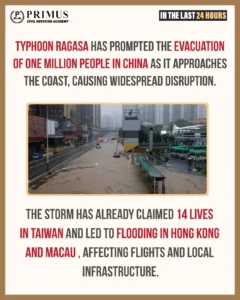
Relevance to UPSC
GS Paper I: Geography
Tropical cyclones, storm dynamics & climate: Understanding how powerful storms form, intensify, and impact regions — relevant from a physical geography and climate change perspective.
Vulnerability & resilience of coastal zones: Hong Kong, Pearl River delta, southern China are coastal and densely populated — issues of storm surge, sea-level rise, urban flooding are pertinent.
Disaster management framework: Evacuation, early warning systems, preparedness, infrastructure resilience—this event is a live case of disaster response in action.
GS Paper III — Environment, Disaster Management & Disaster Resilient Infrastructure
Climate change & extreme weather risks: Such events are expected to increase in frequency/intensity under global warming; this is relevant to India’s climate policies and adaptation strategies.
Economic & infrastructure impact: Disruption of transport, business operations, potential damage to industrial hubs (like the Pearl River delta) has economic fallout.
Transboundary / regional effects: The storm affects multiple countries (Philippines, Taiwan, China) are showing how environmental phenomena don’t respect national boundaries; lessons for regional cooperation.
Security & human displacement: Large evacuations, supply chain disruptions, emergency management tie into human security, internal stability and governance.
More about the News
- Super Typhoon Ragasa, one of the most powerful storms of 2025, is approaching Hong Kong and southern China, with sustained winds over 220 km/h and expected storm surges and flooding.
- Hong Kong has already shut down businesses, transport, and flights in precaution; China has evacuated over a million people in Guangdong province ahead of its landfall.
- In Taiwan, heavy rainfall caused a barrier lake overflow in Hualien County, leading to fatalities and widespread flooding as the typhoon passed.
Cyclones / Typhoons
Cyclones, also known as typhoons or hurricanes depending on the region, are intense tropical storms originating over warm ocean waters, characterized by strong winds, heavy rainfall, and low-pressure centers. They pose significant threats to human life, infrastructure, and the economy, making disaster preparedness and management crucial. With climate change potentially increasing their frequency and intensity, proactive measures are essential for resilience.
Causes of Cyclones
- Formation over warm tropical oceans (≥26°C) providing heat and moisture.
- Coriolis force causing rotation of winds.
- Convergence of low-pressure systems over oceanic regions.
- Vertical wind shear influencing cyclone strength and development.
- Presence of pre-existing disturbances like tropical waves or depressions.
Features of Cyclones
- Circular storm systems with low-pressure centers (eye).
- Strong spiraling winds exceeding 119 km/h in severe cyclones.
- Heavy rainfall leading to floods.
- Storm surges are causing coastal inundation.
- Rapid movement across oceans with potential landfall impacts.
Indian & Global Hotspots
India:
- Bay of Bengal: Odisha, Andhra Pradesh, West Bengal, Tamil Nadu.
- Arabian Sea: Gujarat, Maharashtra, Kerala, Karnataka.
Global:
- Atlantic Ocean: Gulf of Mexico, Caribbean Islands.
- Pacific Ocean: Philippines, Japan, China.
- Indian Ocean: Madagascar, Sri Lanka.
- Australian region: Northern Australia.
Potential for Damage
- Loss of human life and injury.
- Destruction of property and infrastructure.
- Agricultural damage and food insecurity.
- Disruption of transportation, electricity, and water supply.
- Economic losses affecting local and national economies.
Role of Disaster Management Agencies
- Early warning dissemination (IMD in India).
- Evacuation planning and shelter provision.
- Rescue and relief operations during cyclones.
- Post-disaster rehabilitation and reconstruction.
- Community awareness and capacity-building programs.
Impacts of Cyclones
- Human Casualties: Odisha Cyclone (1999) killed over 10,000 people.
- Infrastructure Damage: Cyclone Amphan (2020) caused ₹1.02 lakh crore damage in West Bengal.
- Agricultural Loss: Cyclone Fani (2019) devastated Odisha’s paddy and coconut crops.
- Economic Impact: Philippines Typhoon Haiyan (2013) caused ~$2.98 billion economic losses.
- Environmental Damage: Coastal erosion and mangrove destruction in Andhra Pradesh during Cyclone Hudhud (2014).
Challenges in Curbing Cyclones
- Rapid Onset & Unpredictability: Cyclone Phailin (2013) required sudden evacuation of 1.1 million people.
- Limited Forecasting Accuracy: Cyclone Vardah (2016) had landfall timing uncertainties affecting preparedness.
- Inadequate Infrastructure: Weak coastal embankments fail during storm surges in Odisha.
- Urbanization & Population Density: Kolkata faces high risk due to dense population and poor drainage.
- Climate Change Influence: Rising sea temperatures intensify cyclones like Cyclone Amphan.
Government Measures Taken
- National Cyclone Risk Mitigation Project (NCRMP).
- Early warning systems by the India Meteorological Department (IMD).
- Cyclone shelters and evacuation plans in coastal states.
- Coastal Regulation Zone (CRZ) management and disaster-resilient housing.
- Collaboration with the National Disaster Response Force (NDRF) for rescue operations.
Best Practices
India:
- Odisha’s community-based disaster preparedness and cyclone shelters.
- Andhra Pradesh’s real-time cyclone warning and mass evacuation system.
Global:
- Japan’s advanced cyclone-resistant infrastructure and early warning system.
- Philippines’ Typhoon Preparedness Program including pre-disaster drills and hazard mapping.
Way Forward
- Strengthening predictive meteorological models using AI and satellite data.
- Expanding cyclone-resilient infrastructure in vulnerable regions.
- Enhancing community participation in disaster preparedness.
- Integrating climate change adaptation with disaster management policies.
Names of Cyclones in Different Regions
Region | Name |
North Atlantic | Hurricane |
Northwest Pacific | Typhoon |
South Pacific | Cyclone |
Indian Ocean | Cyclone |
Australia & South Pacific | Cyclone |
With climate change likely to increase the frequency and intensity of cyclones, strengthening early warning systems and resilient infrastructure is crucial. Integrating technology, community preparedness, and sustainable coastal management can significantly reduce human and economic losses. A proactive, adaptive approach will ensure safer and more resilient coastal regions in the future.
Prelims MCQ
Q. Which of the following factors is most critical for the formation of a tropical cyclone?
A. High ocean salinity
B. Warm ocean waters ≥26°C
C. Presence of mountain ranges
D. Low atmospheric humidity
Tropical cyclones derive energy from warm ocean water, which fuels convection and low-pressure development, making it the most critical factor.
Mains Question
Q. Evaluate the effectiveness of India’s disaster management framework in mitigating the impacts of cyclones. Suggest policy measures and technological interventions to enhance resilience in coastal regions.



